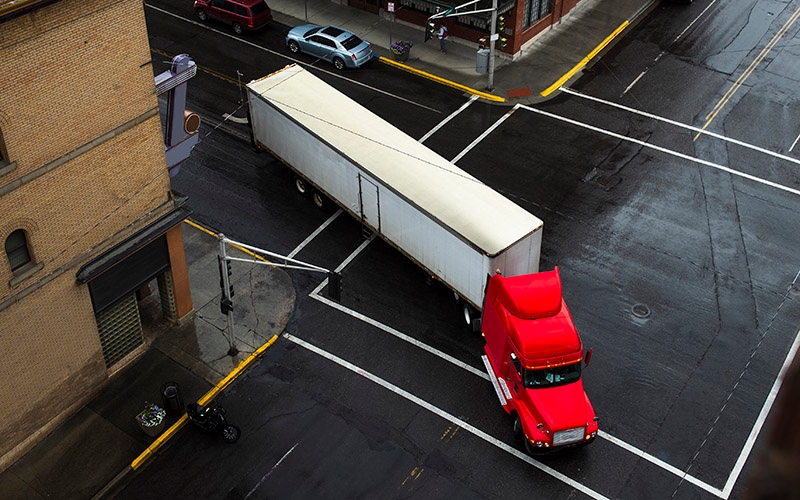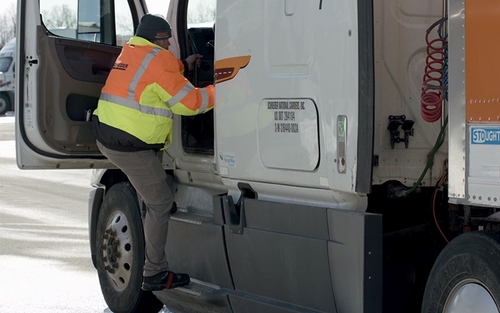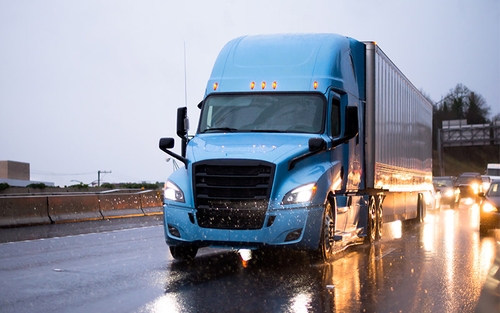6 tips you need to know before truck driving in the city


By The Schneider Guy
Estimated reading time: 3 minutes
Though a lot of a truck driver’s time is spent on highways and interstates, there will be times when driving through large cities is unavoidable.
From heavy traffic to narrow streets and sharp turns, city driving presents some unique challenges for truck drivers to deal with. To prepare yourself to navigate cities safely, check out our most important tips for truck driving in the city.
6 key tips for truck driving in the city
1. Trip plan effectively.
Reviewing your route before hitting the road is one of the easiest ways to prepare for driving a truck in the city. Knowing what signs to watch for and what delays or hazards to expect ahead of time can help you avoid getting lost or flustered while in the moment.
When trip planning a route that includes driving through a large city, it’s essential to familiarize yourself with:
- Which interstate(s) to take, if you will be passing through the city.
- Which exit to take, if you will be driving into the city in order to deliver freight there.
It can also be helpful for drivers to use various tools to scout their route, as no one source includes all the information they need. Use a combination of Google Maps and Apple Maps, an atlas and a GPS to get the full picture of what to expect.
All the usual habits of good trip planning, such as paying attention to the forecast, will help as well.
2. Remove all distractions.
It's just as important to keep your attention on the road when driving through the city as it is when driving on the highway. When driving through the city, drivers should be prepared to make quick decisions.
To stay alert in tight traffic with passenger vehicles, you should:
- Turn down the volume of your music or podcast.
- Or, turn off your radio completely.
- Avoid eating or drinking.
- As always, stay off personal devices.
3. Be a defensive driver.
When driving through a city, drivers must be prepared to deal with a lot more cars in a lot less space. On top of the hazards they should always look for, like distracted drivers, driver need to be aware of:
- Pedestrians.
- Bikers.
- Debris.
- Potholes.
To deal with these additional hazards, drivers should practice defensive driving. Some tips to follow include:
- Scan far and wide. Look a block ahead and check your mirrors every few seconds.
- Keep extra distance. Since traffic is often stop-and-start, provide yourself with extra
- Anticipate others’ actions. Watch for unsafe behavior from other drivers. Take extra time in intersections and while making left turns.
- Signal early. Make your intentions clear to other drivers by signaling at least 100 feet before your turn and leave it on until the turn is complete.
4. Pay close attention to road signs.
Cities often have restricted routes and lanes for semi-trucks, so reading all road signs is a must. Don’t hesitate to read signs two or three times each to ensure you don’t put yourself or others in danger.
Some common things to watch for when city driving include:
- Weight-restricted routes.
- Low clearances.
- One-way streets.
5. Get into the correct lane as soon as possible.
As soon as you can get into the lane where your turn or exit is, make the change. Staying in the wrong lane for too long can lead to missing your exit due to dense traffic.
When changing lanes in a city, be as predictable as possible with your movements. Complete a safe lane change by:
- Checking and double-checking your mirrors and blind spots to ensure there is enough room for you to get over.
- Signaling for at least three seconds to make your intentions clear to other drivers.
- Taking at least seven seconds to complete your lane change (while still keeping an eye on your mirrors).
6. Keep your cool.
City driving can be frustrating. With so much to pay attention to and a lot of time likely spent at a stop, patience can quickly run thin.
Whether you get cut off by a reckless driver or miss a turn, the best way to deal with the frustration is to back off and calm down. Safety always comes first.
Remember, getting angry will only increase your chances of getting in an accident.
Looking for more helpful safety tips?

Schneider Guy loves the "Big Orange." He's passionate about the trucking industry and connecting people to rewarding careers within it. He's been the eyes and ears of our company since our founding in 1935, and he's excited to interact with prospective and current Schneider associates through "A Slice of Orange."



